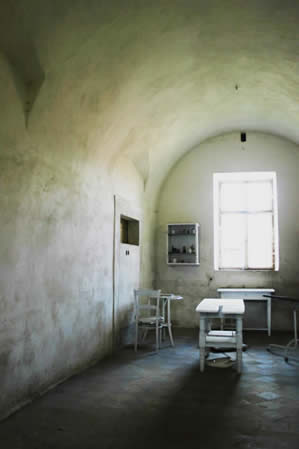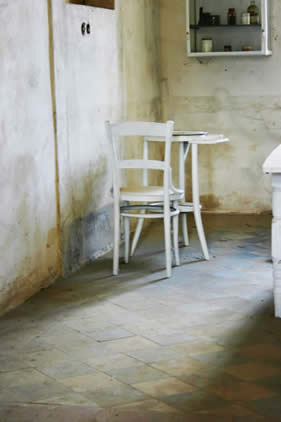Winona Wendth
Lancaster, Massachusetts, United States
|
|
I traveled up to Terezin against my will. My writing instructor had made the assignment. “Just write down what you see,” he said at nine in the morning while we squeezed into the aisle of a public bus headed out from Prague. The vehicle was packed with dozens of laborers on their way to work, a few older couples on their way out of town for a holiday, and ten American students with a writing assignment. “Keep your notebooks open, your minds clear, your attentions focused on what is actually there,” my instructor continued, “Think of your brain as a roll of film, a recording studio. Make sense of it when you go back. Five-hundred words, please. Tomorrow at nine-thirty.”
“Making sense” seemed impossible and more in keeping with the hyper-rationality of the men and women who had calculated a path toward death and suffering for millions of people nearly seventy years before. I resisted the idea as much as I had resisted having to go up to Terezin in the first place. Making sense should not be possible; I did not want to try. I threw my notebook into a bag. And not having a photographic memory, I took my camera with me, too.
By the middle of the afternoon I had walked throughout the compound, dodging tourists and reading extensive discursive signage, trying to come to terms with a place whose purpose was terror and termination. Finally, I stood in a doorway and stared into the one room I believed I could comprehend: a clinic. No experimental procedures here, I had read, only basic, back-to-work patching up and cleaning out. I wanted to imagine a relief from pain in this small space—aspirin, drugs, the binding of a splintered bone.
Students and tourists pushed around, stopped for a moment, and went on. Gavrilo Princip had been held and executed a few doors down; across the yard was a firing wall; the museum with Gestapo uniforms and photographs of famous Czech resistors was about to close. The crowds swarmed and shoved, took pictures of tightly tiered bunks and clothing incinerators, moved to and from their buses. I pushed myself against the doorway and waited for quiet. Photographs are silent, but aural memories of the photographer can contaminate a pictorial study when she revisits her object. I wanted to think about this in stillness and consider the photograph on my own terms.
The door to this treatment room was only a few entrances down on the left from the infamous Arbeit Macht Frei salute whose now chipped and peeling black letters still curve along the top of the arched entryway to the penultimate holding cells at the Terezin fortress. Built in the late eighteenth century for detainment, punishment, and execution, Terezin was one of the darkest places in Czech history, well before its conversion to a concentration camp by the Gestapo during World War II. Over the years, various political motivations and military assaults called for architectural adjustments to both the large and small fortresses. The exam room lay on the edge of the smaller camp. From there, camp detainees were walked over to the far end of the next yard for execution, or back through the archway to trains that took them to Auschwitz-Buchenwald, a day’s rail trip north. In the fall of 1944, a large group of young men were dispatched from Terezin and sent to labor at Auschwitz – the weakest because they took up needed space, the strongest because they posed a threat of rebellion.
Many, of course, did not survive the trip. More than 30,000 men and women were “processed” through this prison camp; 250 or more were executed in the far corner of the fortress. I don’t precisely know how many walked in and out of the clinic, exactly why they were there, or how they walked out. But records of typhus and other debilitating diseases are voluminous—camp management was famous for their meticulous accounts. More than 2500 prisoners died from malnutrition and disease; thousands of others were treated only sufficiently for them to board a boxcar. Physicians in this part of the camp were German, I learned; but the nurses, who like their patients were incarcerates, were often Czech.
I escaped the commotion of the tourists, but I could not dodge the abundance of information coming from that room. The empty chair-desk at the left of the clinic took my attention; the absence of the woman who might have been sitting there held it. Whom would she have been attending? The doctor or the patient? And what would this imagined nurse be documenting, testifying to? The data, the illness, or those who were put in her care? I snapped a photo. And then another. And another.
When I returned to my dorm room, I loaded my photos onto my computer, enlarged them to fill the laptop’s screen, and turned off the lights in order to shut out visual noise. Photographs I had seen at the camp museum provided facial images. I studied the screen and imagined what might have transpired in this clean, spare clinic:
 |
| The examination room at the Little Fortress at Terezin as it presented in 1944 |
A nurse sits at a small table to the left, a doctor stands to the right. A single window between them looks out toward nothing. A young man liberated from Cell Block A shuffles into the room, three or four hundred men like him left behind. Too damaged by beatings, too weak to walk, he is held upright by a barracks guard. To the commandant, he is Kerngesund: able-bodied.
The guard turns the youth around, shoves him back. A shelved wooden examination table catches him at the knees; the guard pushes again. The youth drops backward, sits down and slumps forward. Shelves under his thighs swing up and hold his legs in place. Another shove, and he is lying down, held tight, his limbs away from his torso, the extensions under his legs divided to allow not only for the fluids of dysentery, but also for the straps and buckles necessary to manage procedures.
The doctor nods at a male attendant, who removes the patient’s clothes. The nurse regards the body with her grey-green eyes and places a bucket on the floor underneath her patient’s groin. The boy is listless, perhaps relieved to sit and lie down in the middle of the day; but his eyes do not close. He does not know what will happen next.
The doctor barks something out, his voice dark and rasping. The nurse sits at the table and begins to write, to record. The bruises to the side of the patient’s head tell her that he can probably no longer hear middle registers, can no longer translate some sounds into meaning. She looks up, regards the doctor, then the boy; she stands and puts her hand on her patient’s forehead. She cups his neck under his jaw as a mother would. She holds his cheek, opens his mouth, places a thermometer over his tongue. She watches his brown eyes watching her. She records what she sees, what the instrument tells her, turns a page in her book. Finally, she leans close into the child’s ear and asks in Czech: Boli hlavi? Headache? He stares at her; he nods, his neck stiff. He turns again and stares ahead. She moves away and sits: another entry, another part of her document completed.
In spite of all attempts to gas clothes and fumigate bodies, the boy has typhus, she is sure. His chest shows the telltale rash, already spreading to his limbs. She asks another question in his mother tongue, her lips tight to his ear, closer still to his burning face. She lingers and speaks low, again, “Odjezedy”: departure. She does not know what he hears. She rises and writes something again. He holds his face and moves his head from side to side. His pain is comprehensive. She hesitates again, continues to write and report.
The nurse has recorded his height, the length of his arms and legs, the condition of his teeth. She notes his birth year, 1928, and, lastly, she writes Kerngesund. The doctor stands to the right. He gives the patient something to swallow; the nurse puts ointment on the redness. The doctor barks something else, the guards lift the youth, and a third person comes and gives him another suit of clothes, patched with burlap that will rub away the ointment. The boy waits. Another bark and he is dragged out of the room. The youth tries to move his head, maybe to see the Czech woman, to catch her eye, to help him remember her face and her voice. She looks up briefly. The child is nearly deaf and seems blinded by the shapeless light from the window. The nurse is busy writing: she has documented his name, his birthday, the length of his long bones, the heat of his young body.
My trip back to Prague was a cool and comfortable one. Wanting to reflect on the day in peace, I left Tereisenstadt by myself, after the afternoon had lost its heat and before commuters crowded the bus. Earlier that morning, I had resisted an assignment I believed would force me to confront painful human truths in a place famous for immense suffering and devastation. It had. But standing at the entrance of the empty clinic, I had somehow understood the possibility of care and tenderness even in that most dehumanizing, mechanical, clinical setting. Later in the evening, studying my photographs in the stillness of the dormitory, I saw in the deathly quiet and sparsely furnished room the image of one medical officer indifferently harvesting data, but another touching a boy’s face, registering his heat, apprehending his pain as her own.
WINONA WINKLER WENDTH is a freelance writer who lives and teaches writing and literature near Boston. She taught The History and Philosophy of Health Care at Kettering College of Medical Arts in Dayton, Ohio, where she also worked closely with physician assistants in legislative, community, and international projects. She was the John Woods Scholar and Eda Kriseova Fellow at Univerzita Karlova in Prague for the study of writing and cross-cultural issues in Czech and American literature, and she assisted in editing English translations of the works of Danish philosopher Knud Logstrup and Czech writer Bohumil Hrabal. Her work has appeared or will appear in Spectrum Magazine, Third Coast, Moon Milk Review, Left Hand Waving, and The Yale Journal for Humanities in Medicine, among other places. Wendth holds an MFA from The Bennington Writing Seminars program.
Highlighted in Frontispiece Fall 2010 – Volume 2, Issue 3
Fall 2010 | Sections | Travel


Leave a Reply